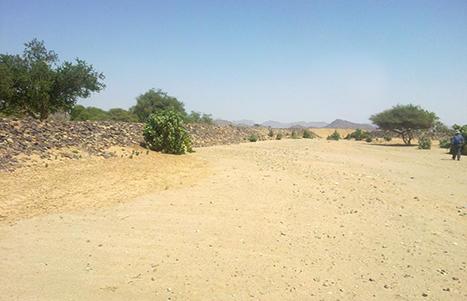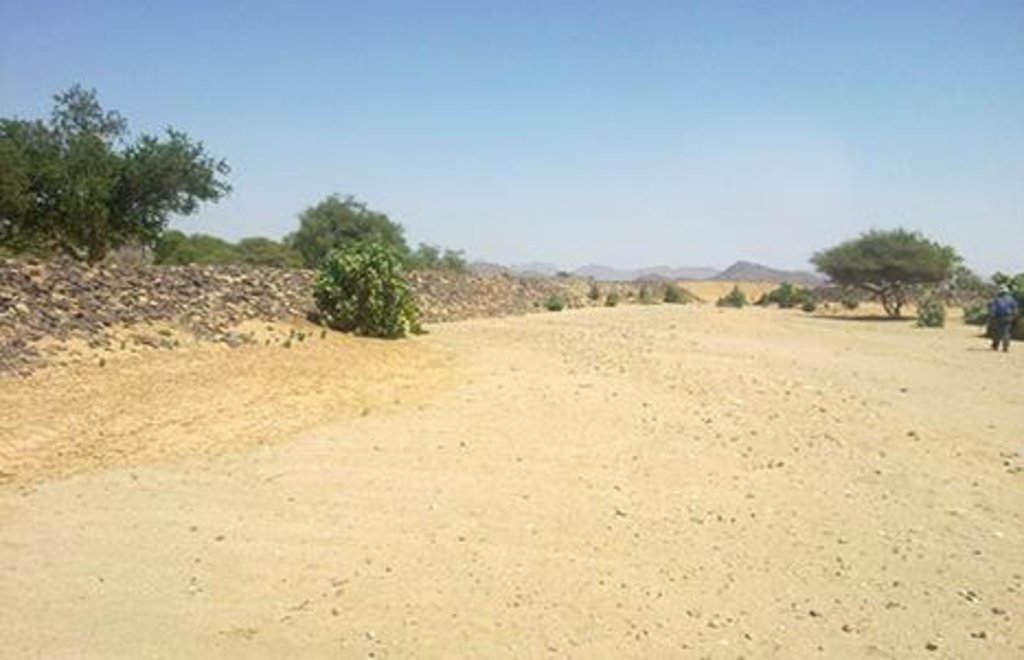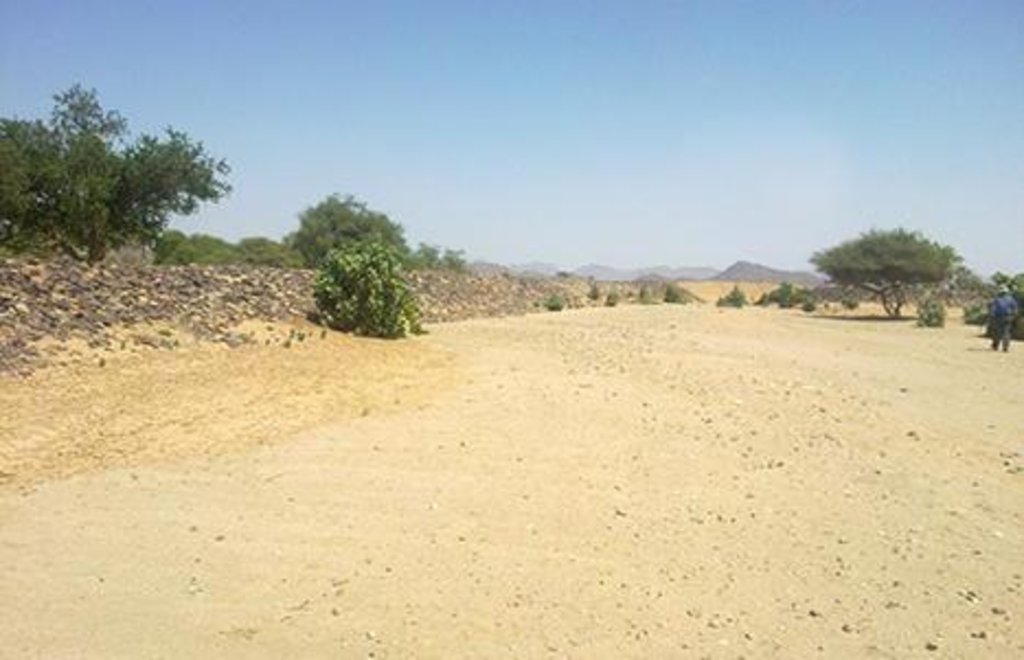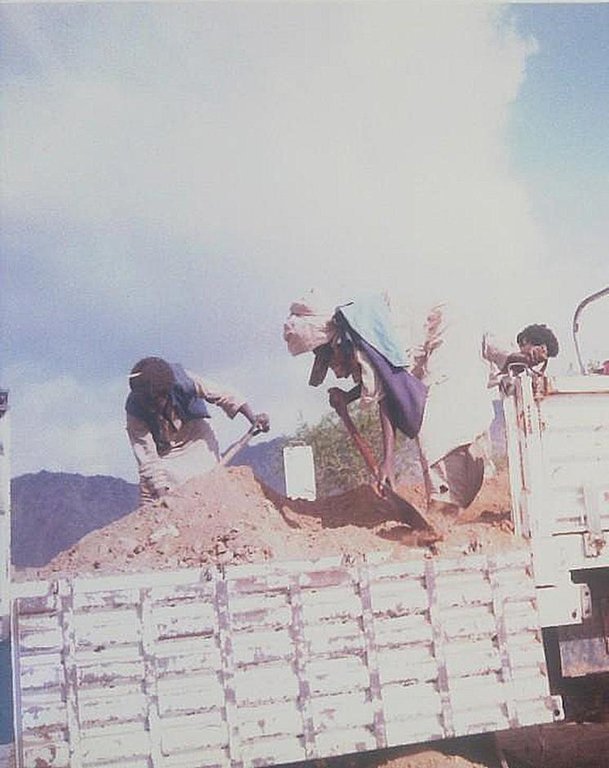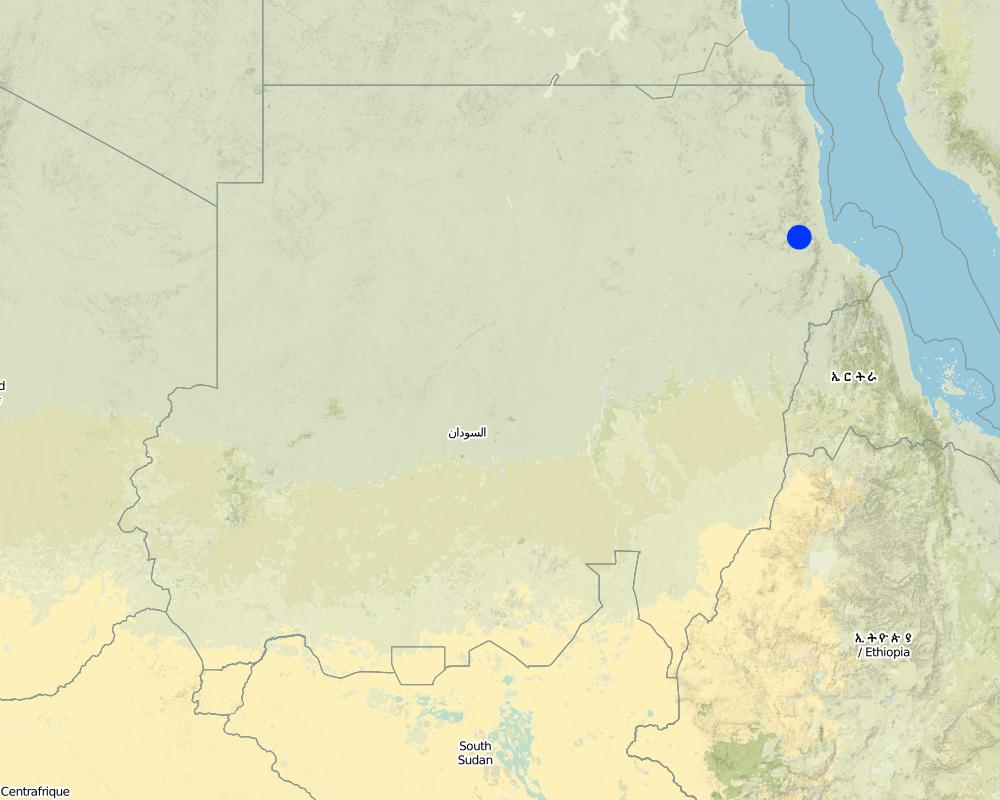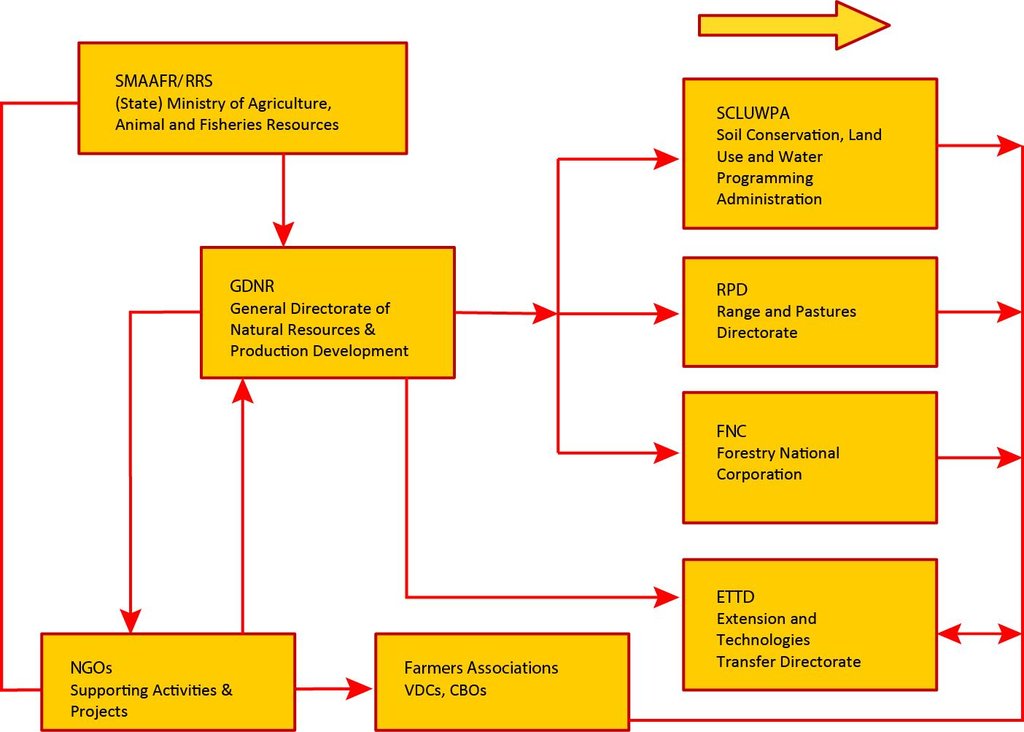Water Spreading (typical example from Hashatribab) [ຊູດານ]
- ການສ້າງ:
- ປັບປູງ:
- ຜູ້ສັງລວມຂໍ້ມູນ: Abdalla Osman Eisa
- ບັນນາທິການ: –
- ຜູ້ທົບທວນຄືນ: David Streiff
Sidud (Local Arabic) - Tarrit (Beja dialect) for earth dams
approaches_2543 - ຊູດານ
ເບິ່ງພາກສ່ວນ
ຂະຫຍາຍທັງໝົດ ຍຸບທັງໝົດ1. ຂໍ້ມູນທົ່ວໄປ
1.2 ລາຍລະອຽດ ການຕິດຕໍ່ ຂອງບຸກຄົນທີ່ຊັບພະຍາກອນ ແລະ ສະຖາບັນ ການມີສ່ວນຮ່ວມ ໃນການປະເມີນຜົນ ແລະ ເອກະສານ ຂອງວິທີທາງ
ຜູ້ຊ່ຽວຊານ ດ້ານການຄຸ້ມຄອງ ທີ່ດິນແບບຍືນຍົງ:
ຜູ້ຊ່ຽວຊານ ດ້ານການຄຸ້ມຄອງ ທີ່ດິນແບບຍືນຍົງ:
Gaiballa Abdelaziz
gaiballa@gmail.com
Sudan University of Science and Technology
ຊູດານ
ຜູ້ຊ່ຽວຊານ ດ້ານການຄຸ້ມຄອງ ທີ່ດິນແບບຍືນຍົງ:
Dabaloub Sayed
+249 912913623
dabaloub@gmail.com
SCLUWPA Dirctor (1986-1995), now the ECDP Centre
Port Sudan
ຊູດານ
ຊື່ຂອງ ສະຖາບັນການຈັດຕັ້ງ ທີ່ອໍານວຍຄວາມສະດວກ ໃນການສ້າງເອກກະສານ ຫຼື ປະເມີນແນວທາງ (ຖ້າກ່ຽວຂ້ອງ)
Soil Conservation, Land Use and Water Adminstratio (Soil Conservation, Land Use and Water Adminstratio) - ຊູດານຊື່ຂອງ ສະຖາບັນການຈັດຕັ້ງ ທີ່ອໍານວຍຄວາມສະດວກ ໃນການສ້າງເອກກະສານ ຫຼື ປະເມີນແນວທາງ (ຖ້າກ່ຽວຂ້ອງ)
VU University Amsterdam (VU University Amsterdam) - ເນເທີແລນຊື່ຂອງ ສະຖາບັນການຈັດຕັ້ງ ທີ່ອໍານວຍຄວາມສະດວກ ໃນການສ້າງເອກກະສານ ຫຼື ປະເມີນແນວທາງ (ຖ້າກ່ຽວຂ້ອງ)
Sudan University of Science and Technology (SUST) - ຊູດານ1.3 ເງື່ອນໄຂ ຂອງການນໍາໃຊ້ເອກກະສານຂໍ້ມູນ ຂອງ WOCAT
ເມື່ອໃດທີ່ໄດ້ສັງລວມຂໍ້ມູນ (ຢູ່ພາກສະໜາມ)?
15/05/2012
ຜູ້ສັງລວມ ແລະ ບັນດາຜູ້ຕອບແບບສອບຖາມ ຍອມຮັບໃນເງື່ອນໄຂ ການນໍາໃຊ້ຂໍ້ມູນເອກະສານ ທີ່ສ້າງຂື້ນ ໂດຍຜ່ານ ອົງການ WOCAT:
ແມ່ນ
1.4 ເອກະສານອ້າງອີງ (ຫຼາຍ) ກັບແບບສອບຖາມ (ຫຼາຍ) ເຕັກໂນໂລຢີ ຂອງດ້ານການຄຸ້ມຄອງ ດິນແບບຍືນຍົງ
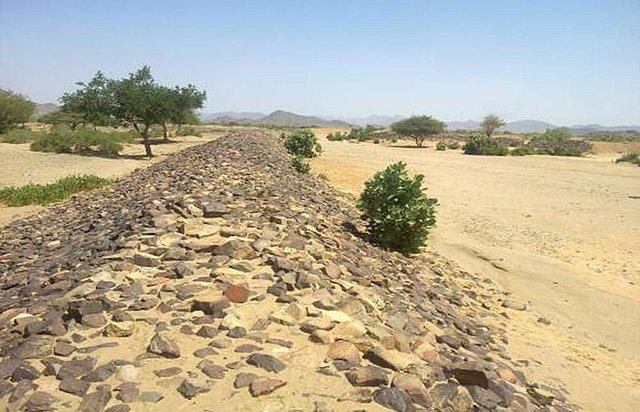
Water Spreading (typical example from Hashatribab) [ຊູດານ]
Water Spreading (or Spate Irrigation system) conducted through the construction of earth dam structures at the khor cross section.
- ຜູ້ສັງລວມຂໍ້ມູນ: Abdalla Osman Eisa
2. ພັນລະນາ ແນວທາງການຄຸ້ມຄອງນໍາໃຊ້ດິນແບບຍືນຍົງ
2.1 ການອະທິບາຍ ໂດຍຫຍໍ້ ຂອງວິທີທາງ
Construction of water spreading system on khor and wadi with machinery jointly government and farmers in dam compaction and pitching.
2.2 ການອະທິບາຍ ລາຍລະອຽດ ຂອງວິທີທາງ
ການອະທິບາຍ ລາຍລະອຽດ ຂອງວິທີທາງ:
Aims / objectives: The main objective of the approach is to enable domestic land users cultivating crops (sorghum mainly) on a flood plain through construction of an earthen, stone-pitched barrier across the bed of a khor (stream). This earth dam serves to divert floodwaters onto their fields downstream. The approach is fully subsidized as the government provide technician and machines for the construction. Only some voluntary contribution from the beneficiaries is needed (for stone pitching). However maintenance support by the government is not provided later on.
This case study is typical of all those in the State. All are demand-driven...In addition the government supports farmers in rural extension e.g. preparedness, awareness, organization and mobilization, and to establish farmers VDCs (Village Development Committee) to guide the community in public works. Training and capacity building sessions in cultural extension are hold to develop crop raising techniques. The aim behind this is mainly to fill the gap of people’s deficiency in storage of crops such as sorghum and millet to maintain food security in the region.
Methods: 1/ Earth dam and terraces construction for water diversion and spreading.
2/ Agronomic measures e.g. ploughing, levelling, furrowing etc. to raise the soil to its maximum capacity.
3/ Provision of certified seeds: Varieties of short mature period and of drought resistance.
4/ Provision of special hand tools for weeding to maintain soil moistures and sustain the growing of crops.
5/ Development of mixed crop systems by provision of cash crop to support the rural economy.
Stages of implementation: 1. Identify and prioritize the needs of local beneficiaries according to their land size, social and economic situation, the local soil types, the cultivated indigenous crops etc.
2. To reach mutual partnership between Government and local communities a certain number of beneficiaries of the community is dedicated to contribute to volunteer manual work.
3. Based on peoples previous natural environment experience the location of the dam is to be examined and an engineering map has to be set out. That means people’s involvement from the very beginning of the project for planning, design and implementation.
4. For construction the government provides necessary needed machines.
5. The local community should mainly ensure the maintenance and the clearing out of the land for smooth water flow.
Role of stakeholders: Division of labor between the stockholders so as to identify the role
1- Land owners: piece of land.
2- Farmers: farming activities.
3- Ministry of Agriculture (MoA): provide machinery and technical support.
4- SLM specialist: will give the technical advice.
Other important information: Floodwater now takes way to any lower area and creates a new water course.
After several years soil should be tilled by ploughing, planking and furrowing to increase water infiltration and percolation as over the years the accumulated silt turns the soils nearly impermeable.
Finally some types of soil in the Red Sea State become very fertile and rich and do not need chemical or organic fertilizers anymore.
2.3 ຮູບພາບຂອງແນວທາງ
2.5 ປະເທດ / ເຂດ / ສະຖານທີ່ບ່ອນທີ່ແນວທາງໄດ້ຖືກນໍາໃຊ້
ປະເທດ:
ຊູດານ
ພາກພື້ນ / ລັດ / ແຂວງ:
Red Sea State
ຂໍ້ມູນເພີ່ມເຕີມຂອງສະຖານທີ່:
Sinkat Locality
ຄວາມຄິດເຫັນ:
This covers the case study of Hashtribab water spreading scheme as documented in the associated QT though is an approach used all over the State. e.g. Erkawit.
Map
×2.6 ວັນທີເລີ່ມຕົ້ນ ແລະ ສິ້ນສຸດ ການຈັດຕັ້ງປະຕີບັດ ວິທີທາງ
ສະແດງປີຂອງການເລີ່ມຕົ້ນ:
1970
2.7 ປະເພດຂອງແນວທາງ
- ພາຍໃຕ້ໂຄງການ / ແຜນງານ
2.8 ເປົ້າໝາຍ / ຈຸດປະສົງຫຼັກ ຂອງການຈັດຕັ້ງປະຕິບັດ ວິທີທາງ
The Approach focused mainly on SLM with other activities (Rehabilitation of natural resources and agriculture for improving soil conditions and fertility. )
To overcome the inability of poor farmers to invest in durable water harvesting schemes and (later; in the 1990s and onwards) to take over the implementational role from NGOs and donors. They could continue to invest but they should be stopped to be concernde with implementation as they were in the 1970s and 1980s
The SLM Approach addressed the following problems: Lack of water to grow crops, lack of money for farmers to invest in infrastructure.
2.9 ເງື່ອນໄຂອໍານວຍ ຫຼື ຂັດຂວາງການປະຕິບັດຂອງເຕັກໂນໂລຢີ / ເຕັກໂນໂລຢີການນໍາໃຊ້ຕາມແນວທາງ
ສັງຄົມ / ວັດທະນະທໍາ / ມາດຕະຖານ ແລະ ຄຸນຄ່າທາງສາສະໜາ
- ເຊື່ອງຊ້ອນ
Lack of machinery and money to construct durable schemes
Treatment through the SLM Approach: Assistance from Government
ມີຄວາມສາມາດ / ເຂັ້າເຖິງຊັບພະຍາກອນດ້ານການເງິນ ແລະ ການບໍລິການ
- ເຊື່ອງຊ້ອນ
1/Limited resources specially in the infrastructure of the concerned government departments
2/ Low capacity of the traditionally adopted technology as well as at farmers communities level.
3/ Limited financial resources especially of extension and capacity building and training at grass root level as well as at staff level
Treatment through the SLM Approach: 1/ Raise the capacity of the technology used
2/ intensive training of both cultural, and rural extension
3/ Training in water harvesting techniques for traditional farmers and in reclamation methods in water management
4/ Encourage farmers innovations and initiatives based on community based approaches for land use management
ການກໍ່ຕັ້ງສະຖາບັນ
- ເຊື່ອງຊ້ອນ
1/ At community level VDCs has low capacity in community organization
2/ Follow up and monitoring is very limited and at an adhoc bases where as carried on occasionally
3/ serious problem as related to water spreading and diversions usually vulnerable to breakage and washed out. The miss located sites of earth dam constriction is the main factor behind
Treatment through the SLM Approach: Raising the capacity of Gov. Dept. in extension techniques and the most develop water harvesting methods
ກ່ຽວກັບກົດໝາຍ (ສິດນໍາໃຊ້ດິນ, ສິດນໍາໃຊ້ນໍ້າ)
- ເຊື່ອງຊ້ອນ
Some conflicts on some areas arise
Treatment through the SLM Approach: Negotiation between parties / stakeholders under their traditional leadership (tribal)
ຄວາມຮູ້ກ່ຽວກັບການຄຸ້ມຄອງ ທີ່ດິນແບບຍືນຍົງ, ການເຂົ້າເຖິງການສະໜັບສະໜູນ ທາງດ້ານວິຊາການ
- ເຊື່ອງຊ້ອນ
Lack of technical training
Treatment through the SLM Approach: Fund for training should be available
ວຽກ, ມີກໍາລັງຄົນ
- ເຊື່ອງຊ້ອນ
partnership between different partners with less extent of homogeneity and commitment.
Treatment through the SLM Approach: strength the linkage between different partners in the targeted activities.
ອື່ນໆ
- ເຊື່ອງຊ້ອນ
Wage differences between NGO staff and government employees
Treatment through the SLM Approach: Top-up payment to government employees
3. ການມີສ່ວນຮ່ວມ ແລະ ບົດບາດຂອງພາກສ່ວນທີ່ກ່ຽວຂ້ອງທີ່ໄດ້ມີສ່ວນຮ່ວມ
3.1 ຜູ້ມີສ່ວນຮ່ວມ ໃນວິທີທາງ ແລະ ພາລະບົດບາດ ຂອງເຂົາເຈົ້າ
- ຜູ້ນໍາໃຊ້ດິນໃນທ້ອງຖິ່ນ / ຊຸມຊົນທ້ອງຖິ່ນ
Farmers with VDCs and individuals.
The adult (40 years) and youth (20 – 30 years). Rarely it has be taken by women
It can be said that the whole community is economically disadvantaged
Men predominant in meeting and negotiations. This were conducted through the VDC's and community elected community board.
- ຜູ້ຊ່ຽວຊານ ການນຄຸ້ມຄອງ ທີ່ດິນແບບຍືນຍົງ / ທີ່ປຶກສາດ້ານກະສິກໍາ
Extension agents
- ອົງການຈັດຕັ້ງ ທີ່ບໍ່ຂື້ນກັບລັດຖະບານ
- ພະນັກງານຂັ້ນສູນກາງ (ຜູ້ວາງແຜນ, ຜູ້ສ້າງນະໂຍບາຍ)
Soil Conservation Department (SCLUWPA) (named differently in different parts of the country), Range and Pastures and Forestry Dirctorates
Community leaders (tribal), Localities assembly, VDCs, Community representatives and Ministers at State level
3.2 ການມີສ່ວນຮ່ວມຂອງຜູ້ນໍາໃຊ້ທີ່ດິນໃນທ້ອງຖິ່ນ / ຊຸມຊົນທ້ອງຖິ່ນໃນໄລຍະທີ່ແຕກຕ່າງກັນຂອງແນວທາງ
| ການລວບລວມ ເອົາຜູ້ນໍາໃຊ້ດິນ ໃນທ້ອງຖິ່ນ / ຊຸມຊົນທ້ອງຖິ່ນ | ໃຫ້ລະບຸ ຜູ້ໃດທີ່ມີສ່ວນຮ່ວມ ໃນແຕ່ລະກິດຈະກໍາ? | |
|---|---|---|
| ການເລີ່ມຕົ້ນ / ແຮງຈູງໃຈ | ການນໍາໃໍຊ້ເອງ | Demand-driven |
| ການວາງແຜນ | ການຮ່ວມມື | Together with specialists |
| ການປະຕິບັດ | ການຮ່ວມມື | Some subsidized labour and in some cases volonteer labours |
| ຕິດຕາມກວດກາ / ການປະເມີນຜົນ | ບໍ່ມີ | None |
| Research | ບໍ່ມີ | Some information provided |
3.3 ແຜນວາດ (ຖ້າມີ)
ການອະທິບາຍ:
Institutional framework: Stakeholders and their roles: cross-disciplinary linkages between SMAAFR, collaborating institutions and farmers.
ຜູ້ຂຽນ:
Abdalla Osman Eisa (Soil Conservation and Land Use Admin. Red Sea State, Sudan)
3.4 ການຕັດສິນໃຈກ່ຽວກັບການຄັດເລືອກເຕັກໂນໂລຢີຂອງການຄຸ້ມຄອງທີ່ດິນແບບຍືນຍົງ / ເຕັກໂນໂລຢີ
ລະບຸ ຄົນທີ່ຕັດສິນໃຈ ກ່ຽວກັບການຄັດເລືອກຂອງ ເຕັກໂນໂລຢີ / ເຕັກໂນໂລຢີ ຈະໄດ້ຮັບການປະຕິບັດ:
- ຜູ້ນໍາໃຊ້ທີ່ດິນຫຼັກ, ການສະໜັບສະໜູນ ໂດຍຜູ້ຊ່ຽວຊານ ການນໍາໃຊ້ທີ່ດິນແບບຍືນຍົງ
ອະທິບາຍ:
Most of the schemes (of which Hashatribab is a good example) began as a traditional water spreading schemes. Thus the Government built upon the traditionally adopted farmer's technology and developed it my means of improved soil and crop management knowledges and capacity bulding to farmers.
Decisions on the method of implementing the SLM Technology were made by mainly by SLM specialists with consultation of land users. The machinery necessary was in the hands of the Government and the specialists knew what was possible and how it could be done. But for all the land users were consulted.
To develop the traditionally adopted technology it is in the hand of the people themselves and need to be supported by the government. Such technology men are dealing with the natural resources, preventing tree cutting, moving regularly for grazing governance to recover ranges etc. and also they need hand tools awareness techniques.
4. ການສະໜັບສະໜູນທາງດ້ານວິຊາການ, ການສ້າງຄວາມສາມາດ, ແລະ ການຈັດການຄວາມຮູ້.
4.1 ການສ້າງຄວາມສາມາດ / ການຝຶກອົບຮົມ
ຜູ້ນໍາໃຊ້ທີ່ດິນ ຫຼື ພາກສ່ວນກ່ຽວຂ້ອງອື່ນໆ ໄດ້ຮັບການຝຶກອົບຮົມບໍ່?
ແມ່ນ
ໃຫ້ລະບຸ ຜູ້ໃດທີ່ໄດ້ຮັບການຝຶກອົບຮົມ:
- ຜູ້ນໍາໃຊ້ດິນ
- ພະນັກງານພາກສະໜາມ / ທີ່ປຶກສາ
- other related goverment Departments
ຖ້າເປັນໄປໄດ້, ໃຫ້ລະບຸເພດ, ອາຍຸ, ສະຖານະພາບ, ຊົນເຜົ່າ, ແລະ ອື່ນໆ:
on gender basis.
ຮູບແບບຂອງການຝຶກອົບຮົມ:
- ຕົວຕໍ່ຕົວ
- ກອງປະຊຸມ
ໃນຫົວຂໍ້:
Rural extension as community organization, public work methods, extension and awareness services
4.2 ການບໍລິການໃຫ້ຄໍາປຶກສາ
ເຮັດຜູ້ໃຊ້ທີ່ດິນມີການເຂົ້າເຖິງການບໍລິການໃຫ້ຄໍາປຶກສາ?
ແມ່ນ
ລະບຸວ່າການສະໜອງ ການບໍລິການ ໃຫ້ຄໍາປຶກສາ:
- ໃນພື້ນທີ່ຂອງຜູ້ນໍາໃຊ້ດິນ
ອະທິບາຍ / ຄວາມຄິດເຫັນ:
Conventional extension; Key elements: 1.Visits, 2.Training, 3.Practice and training by doing ; Cross visits are very important to improve the technical know how and to learn by experience. The practical training is very useful and effective rather to the theoretical one.
Advisory service is quite adequate to ensure the continuation of land conservation activities; Yes, in terms of technical know how but not in terms of adequate resources
4.3 ສະຖາບັນການສ້າງຄວາມເຂັ້ມແຂງ (ການພັດທະນາອົງການຈັດຕັ້ງ)
ສະຖາບັນ ໄດ້ຮັບການສ້າງຕັ້ງຂື້ນ ຫຼື ໄດ້ຮັບການສ້າງຄວາມເຂັ້ມແຂງ ໂດຍການຈັດຕັ້ງປະຕິບັດ ວິທີທາງບໍ່?
- ມີ, ໜ້ອຍໜຶ່ງ
ລະບຸ ທາງສະຖາບັນ ໄດ້ສ້າງຄວາມເຂັ້ມແຂງ ໃນລະດັບໃດ (ຫຼາຍ):
- ທ້ອງຖິ່ນ
- man power
ໃຫ້ລາຍລະອຽດເພີ່ມເຕີມ:
Because the local institution was involved in negotiations with the Government and also organizing communities; mobilization and awareness. SCLUWPA activities are mainly oriented to conserve soil and vegetation. They tend to clarify land according to the amount of Khor floods into land for agriculture and the land of forests and ranges. This practice is carried on down streams of seasonal rivers while is not specifically going in plains which in need to be reclaimed to reduce sand dunes formation and desert like conditions
4.4 ຕິດຕາມກວດກາ ແລະ ປະເມີນຜົນ
ການຈັດຕັ້ງປະຕິບັດ ວິທີທາງ ໄດ້ມີການປະເມີນຜົນ ແລະ ຕິດຕາມບໍ?
ແມ່ນ
ຄວາມຄິດເຫັນ:
There were no changes in the Approach as a result of monitoring and evaluation: Not relevant as no monitoring took place. Only monitoring and evaluation is carried on by SCLUWPA for its activities in earth dams' construction and terraces to speed water. Usually this takes places after and within the period of flooding in addition to sea wall, effectively these devices functioned and finally to trace the impact and the outcome.
There were no changes in the Technology as a result of monitoring and evaluation: as above. In purpose of to check what have done to do some amendments.
4.5 ການຄົ້ນຄວ້າ
ນີ້້ແມ່ນສ່ວນໜຶ່ງ ການຄົ້ນຄວ້າ ຂອງວິທີທາງບໍ່?
ແມ່ນ
ລະບຸ ຫົວຂໍ້:
- ລະບົບນິເວດ
5. ການສະໜັບສະໜູນທາງດ້ານການເງິນ ແລະ ອຸປະກອນຈາກພາຍນອກ
5.1 ງົບປະມານປະຈໍາປີ ສໍາລັບວິທີທາງ ຂອງການຄຸ້ມຄອງ ທີ່ດິນແບບຍືນຍົງ
ຖ້າຫາກບໍ່ຮູ້ຈັດງົບປະມານທີ່ແນ່ນອນ ແມ່ນໃຫ້ປະມານເອົາ:
- 2,000-10,000
ຄໍາເຫັນ (ຕົວຢ່າງ: ແຫຼ່ງຂໍ້ມູນຫຼັກ ຂອງການສະໜອງທຶນ / ຜູ້ໃຫ້ທຶນທີ່ສໍາຄັນ):
Approach costs were met by the following donors: international (Training, capacity building and assistance of equipment.): 30.0%; government (Technical staff, equipment and agricultural inputs.): 60.0%; local community / land user(s) (Volunteer man power): 10.0%
5.2 ການສະໜັບສະໜູນ ທາງດ້ານການເງິນ / ອຸປະກອນ ສະໜອງໃຫ້ແກ່ຜູ້ນໍາທີ່ດິນ
ຜູ້ນໍາໃຊ້ດິນ ໄດ້ຮັບການສະໜັບສະໜູນ ທາງດ້ານ ການເງິນ / ອຸປະກອນ ໃນການຈັດຕັ້ງປະຕິບັດ ເຕັກໂນໂລຢີບໍ?
ແມ່ນ
ຖ້າແມ່ນ, ໃຫ້ລະບຸປະເພດ (ຫຼາຍ) ຂອງການສະໜັບສະໜູນ, ເງື່ອນໄຂ ແລະ ຜູູ້ສະໜອງ (ຫຼາຍ):
By Government either directly or from donor sources. SCLUWPA, Range and Pastures, UNDP and UNISCO supporting desertification.
5.3 ເງິນສົມທົບສໍາລັບການນໍາໃຊ້ສະເພາະປັດໃຈຂາເຂົ້າໃນການຜະລີດກະສິກໍາ (ລວມທັງແຮງງານ)
- ອຸປະກອນ
| ໃຫ້ລະບຸໄດ້ຮັບການສະໜັບສະໜູນປັດໃຈຂາເຂົ້າຫຍັງແດ່ | ທີ່ຂອບເຂດ | ລະບຸ ການອຸດໜູນ |
|---|---|---|
| ເຄື່ອງມື | ງົບປະມານເຕັມສ່ວນ | |
- ກະສິກໍາ
| ໃຫ້ລະບຸໄດ້ຮັບການສະໜັບສະໜູນປັດໃຈຂາເຂົ້າຫຍັງແດ່ | ທີ່ຂອບເຂດ | ລະບຸ ການອຸດໜູນ |
|---|---|---|
| ແນວພັນ, ແກ່ນພັນ | ງົບປະມານເຕັມສ່ວນ | |
- ການກໍ່ສ້າງ
| ໃຫ້ລະບຸໄດ້ຮັບການສະໜັບສະໜູນປັດໃຈຂາເຂົ້າຫຍັງແດ່ | ທີ່ຂອບເຂດ | ລະບຸ ການອຸດໜູນ |
|---|---|---|
| ຫີນ | ງົບປະມານບາງສ່ວນ | partial community contribution |
| ໄມ້ | ງົບປະມານບາງສ່ວນ | partial community contribution |
ຖ້າແຮງງານ ຂອງຜູ້ນໍາໃຊ້ດິນ ໄດ້ຮັບການສະໜັບສະໜູນ ປັດໃຈຂາເຂົ້າ, ແມ່ນບໍ່:
- ການອາສາ
ຄວາມຄິດເຫັນ:
see QT
Only machinery financed for construction period and maintenance.
Labour appears in all mentioned forms above. But voluntarely and food for work is most common.
5.4 ສິນເຊື່ອ
ໄດ້ປ່ອຍສິນເຊື່ອ ສະໜອງໃຫ້ພາຍໃຕ້ ວິທີການສໍາລັບກິດຈະກໍາ ການຄຸ້ມຄອງ ທີ່ດິນແບບຍືນນຍົງບໍ່?
ບໍ່ແມ່ນ
6. ວິເຄາະຜົນກະທົບ ແລະ ສັງລວມບັນຫາ
6.1 ຜົນກະທົບຂອງແນວທາງ
ການຈັດຕັ້ງປະຕິບັດ ວິທີທາງ ສາມາດຊ່ວຍຜູ້ນໍາໃຊ້ທີ່ດິນ ໃນການຈັດຕັ້ງປະຕິບັດ ແລະ ບໍາລຸງຮັກສາ ເຕັກໂນໂລຢີ ການຄຸ້ມຄອງ ທີ່ດິນແບບຍືນຍົງໄດ້ບໍ?
- ບໍ່
- ມີ, ໜ້ອຍໜຶ່ງ
- ມີ, ພໍສົມຄວນ
- ມີ, ຫຼາຍ
They were able to make the land directly more productive because of the extra water. Furthermore it helped land users in raising their technical know how.
ການຈັດຕັ້ງປະຕິບັດ ວິທີທາງ ສາມາດສ້າງຄວາມເຂັ້ມແຂງ ທາງສັງຄົມ ແລະ ເສດຖະກິດບໍ່?
- ບໍ່
- ມີ, ໜ້ອຍໜຶ່ງ
- ມີ, ພໍສົມຄວນ
- ມີ, ຫຼາຍ
Yes, as the whole community was economically disadvantaged
ການຈັດຕັ້ງປະຕິບັດ ວິທີທາງ ສາມາດປັບປຸງ ປະເດັນການຖືຄອງທີ່ດິນ / ສິດທິໃນການນໍາໃຊ້ທີ່ດິນ ທີ່ເຊື່ອງຊ້ອນໃນການຈັດຕັ້ງປະຕິບັດ ເຕັກໂນໂລຢີ ການຄຸ້ມຄອງ ທີ່ດິນແບບຍືນຍົງໄດ້ບໍ?
- ບໍ່
- ມີ, ໜ້ອຍໜຶ່ງ
- ມີ, ພໍສົມຄວນ
- ມີ, ຫຼາຍ
no problems related to that issue of land rights and ownership and early can be recognized by tribal leadership. The problem is likely to be overcome in the near future. within the tribal system it can be solved any problems on land in cases of difficulties the leadership take decision to be used by all members.
Did other land users / projects adopt the Approach?
- ບໍ່
- ມີ, ໜ້ອຍໜຶ່ງ
- ມີ, ພໍສົມຄວນ
- ມີ, ຫຼາຍ
Not relevant as it is a government driven system. The newly introduced technology is to improve before it can be adopted by other land users.
Did the Approach lead to improved livelihoods / human well-being?
- ບໍ່
- ມີ, ໜ້ອຍໜຶ່ງ
- ມີ, ພໍສົມຄວນ
- ມີ, ຫຼາຍ
Yes, because of extra food supply – though not as dramatic as with irrigation By using simple technology e.g. the hand tools and ohter manually applicable implements can be used easily by land users.
Did the Approach help to alleviate poverty?
- ບໍ່
- ມີ, ໜ້ອຍໜຶ່ງ
- ມີ, ພໍສົມຄວນ
- ມີ, ຫຼາຍ
In terms of food security: but differs from season to season If support subsistence farmers to produce crop and animal herders to multiply animal numbers.
6.2 ແຮງຈູງໃຈຫຼັກຂອງຜູ້ນໍາໃຊ້ທີ່ດິນໃນການປະຕິບັດການຄຸ້ມຄອງທີ່ດິນແບບຍືນຍົງ
- ການຜະລິດເພີ່ມຂຶ້ນ
The primary motivation
- well-being and livelihoods improvement
Also very important
6.3 ຄວາມຍືນຍົງຂອງກິດຈະກໍາວິທີທາງ
ຜູ້ນໍາໃຊ້ ທີ່ດິນ ສາມາດສືບຕໍ່ ການຈັດຕັ້ງປະຕິບັດ ຜ່ານວິທີທາງໄດ້ບໍ່ (ໂດຍປາດສະຈາກ ການຊ່ວຍເຫຼືອ ຈາກພາກສ່ວນພາຍນອກ)?
- ບໍ່ມີ
ຖ້າ ບໍ່ ຫຼື ບໍ່ແນ່ໃຈ, ໃຫ້ອະທິບາຍ ແລະ ຄໍາເຫັນ:
The land users can continue to crop and to maintain structures within their ability, but no expansion would be possible or repairs to major breakages, unless the level of surplus production will be reached.
6.4 ຈຸດແຂງ / ຂໍ້ດີ ຂອງວິທີທາງ
| ຈຸດແຂງ / ຂໍ້ດີ / ໂອກາດໃນການນໍາໃຊ້ທີ່ດິນ |
|---|
|
1) Improve the socioeconomic situation. 2) Learning and improve their technical capacity. 3) Raising the community awareness and preparedness. 4) Encourage peoples to be involved in collective action. 5) Enhance their capacity of community effective. Management resources (How to sustain/ enhance this strength: -Building and strengthening the establishment of the community institutions i.e. from VDCs to local Community Base Organization CBos national NGos.) |
| ຈຸດແຂງ / ຈຸດດີ / ໂອກາດ ຈາກທັດສະນະຂອງຜູ້ປ້ອນຂໍ້ມູນ ຫຼື ບຸກຄົນສຳຄັນ |
|---|
|
1/ Demand driven response to people’s needs. 2/ Reducing the direct in-field role of NGOs. 3/ Progress to create a national Ngo's. 4/ Building the community institution. 5/ Raising the self help and self reliance for sustainable management. (How to sustain/ enhance this strength: 1/ Continue to listen to the people 2/ By making sure the Government continues to play that role effectively 3/Increase funding . ) |
6.5 ຈຸດອ່ອນ / ຂໍ້ເສຍຂອງແນວທາງ ແລະ ວິທີການແກ້ໄຂໃຫ້ເຂົາເຈົ້າ
| ຈຸດອ່ອນ / ຂໍ້ເສຍ / ຄວາມສ່ຽງໃນມູມມອງຂອງຜູ້ນໍາໃຊ້ທີ່ດິນ | ມີວິທີການແກ້ໄຂຄືແນວໃດ? |
|---|---|
|
1) Weak economic base at rural areas. 2) Weak community innovation and involvement. 3) Illiteracy and isolated and knowledge of others experiences 4) Low level of the technology used by the people. 5) Poverty and high vulnerability to natural disasters. |
- to increase land productivity. - to develop crop mixing strategy to include cash crops. - enhance and encourage agroforestry approach. |
| ຈຸດອ່ອນ ຫຼື ຂໍ້ເສຍ ຫຼື ຄວາມສ່ຽງ ໃນມຸມມອງຂອງ ຜູ້ສັງລວມຂໍ້ມູນ ຫຼື ບັນດາຜູ້ຕອບແບບສອບຖາມ | ມີວິທີການແກ້ໄຂຄືແນວໃດ? |
|---|---|
|
1/ Weak of funds. 2/ Weak of monitoring and evaluation. 3/ Low of documentation and knowledge sharing. 4) Lack of research involvement. It is better to say few or adequate research activity |
1/ More support. 2/ Introduce a clear, simple system. 3/ International community need to make more efforts to assist with these aspects. 4/ Both Government and NGOs need to recognise the potential role of researchers |
7. ເອກກະສານອ້າງອີງ ແລະ ຂໍ້ມູນການເຊື່ອມໂຍງ
7.1 ວິທີການ / ແຫຼ່ງຂໍ້ມູນ
- ການໄປຢ້ຽມຢາມພາກສະໜາມ, ການສໍາຫຼວດພາກສະໜາມ
ຂໍ້ມູນການເຊື່ອມຕໍ່ ແລະ ເນື້ອໃນ
ຂະຫຍາຍທັງໝົດ ຍຸບທັງໝົດການເຊື່ອມຕໍ່

Water Spreading (typical example from Hashatribab) [ຊູດານ]
Water Spreading (or Spate Irrigation system) conducted through the construction of earth dam structures at the khor cross section.
- ຜູ້ສັງລວມຂໍ້ມູນ: Abdalla Osman Eisa
ເນື້ອໃນ
ບໍ່ມີເນື້ອໃນ


